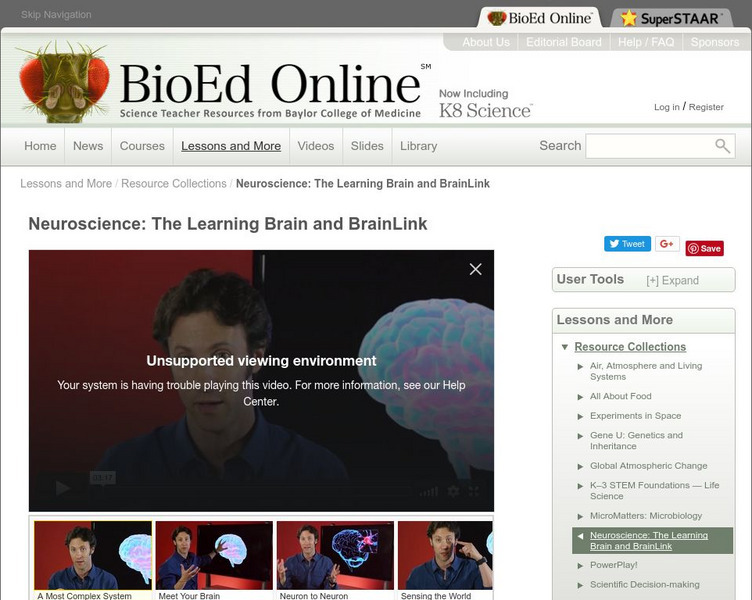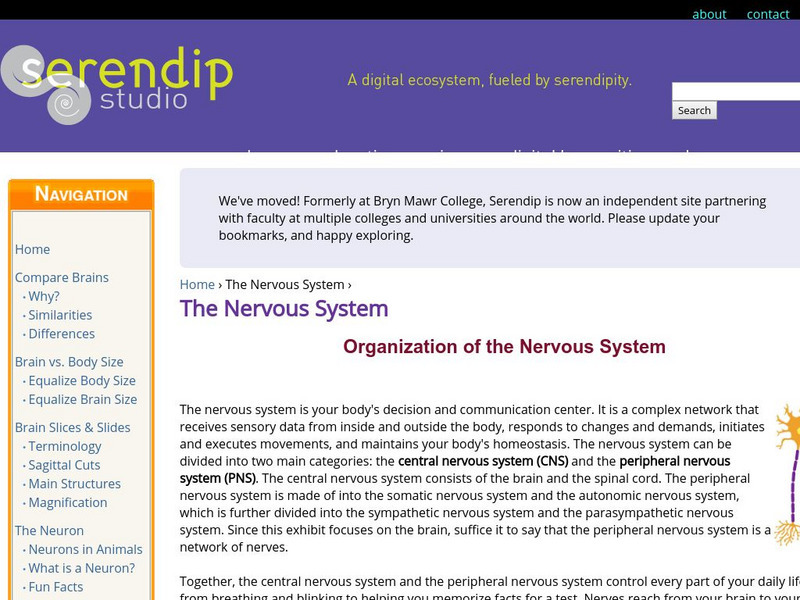PBS
Pbs Learning Media: Brain Geography
Which part of your brain controls your ability to swallow? Your instinct to survive? And how do all the brain's parts function cooperatively? Find out with this interactive feature from the NOVA: "Coma" Web site.
BioEd Online
Bio Ed Online: The Learning Brain: Neuroscience
This series of videos introduces students to the brain, including why it is so special, its parts and functions and how it recalls memories and stores new information. Other videos explain how the brain processes sensory information and...
OpenStax
Open Stax: Anatomy & Physiology: The Cranial Nerve Exam
Students learn about the functional grouping of cranial nerves and match the regions of the forebrain and brain stem that are connected to each cranial nerve.
OpenStax
Open Stax: Anatomy & Physiology: The Mental Status Exam
Students understand the relationship of mental status exam results to cerebral functions in the cerebral cortex.
TeachEngineering
Teach Engineering: Hearing: How Do Our Ears Work?
Students learn about the anatomy of the ear and how the ears work as a sound sensor. Ear anatomy parts and structures are explained in detail, as well as how sound is transmitted mechanically and then electrically through them to the...
PBS
Pbs Teachers: Scientific American: Make Up Your Mind: Mind Mapping
Investigate the pseudoscience of phrenology and its attempt to organize and assign different purposes to different parts of the brain. Create a phrenology chart on a bathing cap and compare it to modern understanding of brain function...
BBC
Bbc: Gcse Bitesize: How Does the Nervous System Help Us Respond? Ocr 21 C
This lesson focuses on the areas of the brain and the functions of each area. It includes a diagram of the brain with areas labeled, a table of the functions of the areas, and a link to a test.
Georgia State University
Georgia State University: Hyper Physics: The Auditory Nerve
A good description and function of the auditory nerve. Diagrams, explanations.
The Tech Interactive
Tech Museum of Innovation: Inside Your Eyeball
After discussing the basics of the eye, this site explores the various functions of the eye and parts from the optic nerves to the retina. Cones, rods, and the brain are also discussed.
PBS
Pbs Learning Media: Everest: Test Your Brain Under Low Oxygen Conditions
This interactive feature from the NOVA: "Everest" Web site lets you take the same brain quizzes that researchers have used to test the brain function of climbers on Mount Everest.
York University
Classics in the History of Psychology: Principles of Psychology by William James
Complete volumes of the two volumes of this work are available for study.
California Academy of Sciences
California Academy of Sciences: Skulls
A skull is an object of sculptural beauty, a machine designed by evolution, a blueprint of an animal's lifestyle, and a protective enclosure for the brain and sensory organs. These are all responses given by scientists on this visually...
National Geographic
National Geographic: Seeing Is Believing
In this lesson, students investigate the properties of light using simple materials. Includes handout and video resources.
Science4Fun
Science4 Fun: Brain
Learn fun and interesting facts about the brain, its parts, how it communicates, and memory.
Curated OER
Meninges of the Brain
Contains a brief description and diagram of the meninges of the brain. Also mentions the functions of the meninges.
PBS
Pbs Teachers: Test Your Brain
Investigate the effect of oxygen deprivation on brain function and test the changes in mental abilities climbers experience as they climb to ever-higher altitudes, in this virtual experiment.
PBS
Pbs Teachers: Scientific American: New Research Into Dyslexia
Research the array of sophisticated technologies scientists use to look closely at the brain. Diagram the major lobes of the brain and explore the functions of the frontal lobe to learn about how dyslexic individuals process information.
Bryn Mawr College
Serendip: The Nervous System
Learn about the main sections of the human brain, and how the structure or each relates to its function.
TED Talks
Ted: Ted Ed: Your Brain Is More Than a Bag of Chemicals
Modern psychiatric drugs treat the chemistry of the whole brain, but neurobiologist David Anderson believes in a more nuanced view of how the brain functions. He illuminates new research that could lead to targeted psychiatric...
Wikimedia
Wikipedia: Hypothalamus
This site from the encyclopedia, Wikipedia, provides a brief open-source encyclopedic explanation of what the hypothalamus is and what its functions are. Links are provided throughout this paragraph along with a picture showing where the...
TED Talks
Ted: Ted Ed: The Coming Neurological Epidemic
Biochemist Gregory Petsko makes a convincing argument that, in the next 50 years, we'll see an epidemic of neurological diseases, such as Alzheimer's, as the world population ages. His solution: more research into the brain and its...
CommonLit
Common Lit: "Let's See What You're Made Of" by Bird Brain Science
This informational, scientific text explains how cells, the smallest unit of a living organism, make up every living thing in the world. As you read, take notes on the comparisons used in the text to explain how cells work. [Free account...
PBS
Pbs Teachers: Mystery of the Senses Vision
Understand how our brain identifies an object, view six optical illusions and explain why the visual system might interpret them the way it does.
Science Buddies
Science Buddies:brain Body Connection: Can Exercise Make Our Brains Work Better?
We all know physical exercise is important to keeping our bodies fit. But how important is physical exercise to your brain? In other words, is there any connection between an active body and increased brain power? This is an easy project...



















